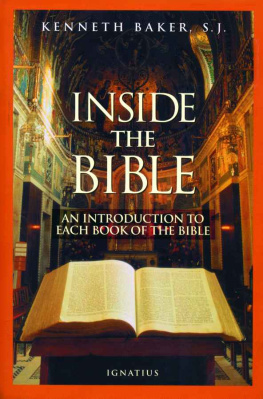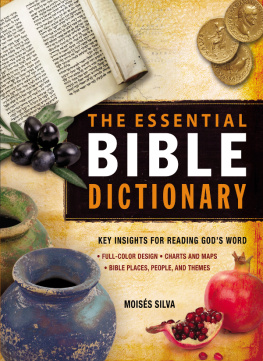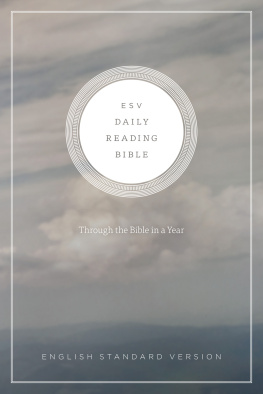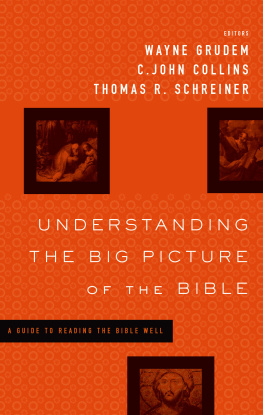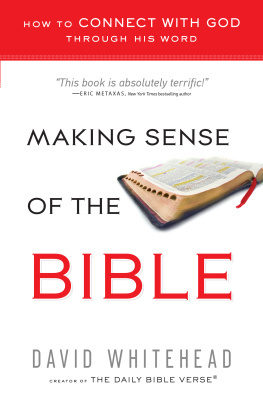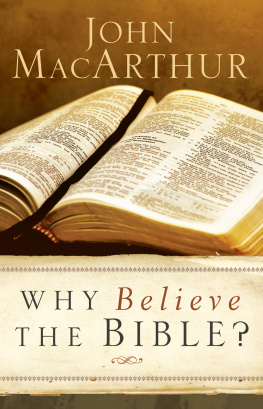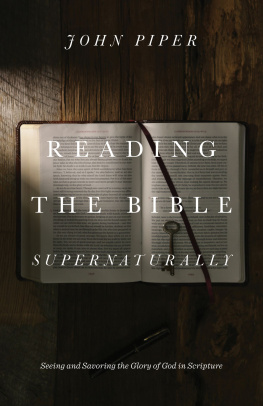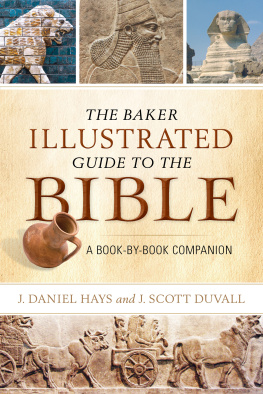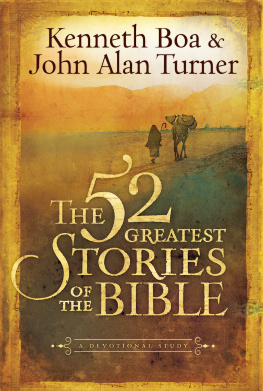Inside the Bible
KENNETH BAKER, S.J.
Inside the Bible
An Introduction to
Each Book of the Bible
IGNATIUS PRESS SAN FRANCISCO
Cover design by Roxanne Mei Lum
1998 Ignatius Press, San Francisco
All rights reserved
ISBN 978-0-89870-665-9
Library of Congress catalogue number 98-71260
Printed in the United States of America
Contents
Introduction
The Bible contains the word of God. It is a collection of letters that God has written to us to tell us where we came from, why we are here, and where we are going. God is the primary author of the Bible, but he used human beings as his instruments to produce itmen like Moses, David, Amos, Isaiah, Matthew, Mark, Luke, John, Paul, and the other prophets and wise men. In all they wrote they were protected from error by the assistance of the Holy Spirit.
The Catholic Bible contains forty-five books in the Old Testament, or forty-six if Lamentations is separated from Jeremiah. The New Testament has twenty-seven books, fourteen, or over half of them, by St. Paul.
A believer who wants to read and study the Bible should realize that it takes effort to come to a good understanding of the contents of the Greatest Book ever written. It takes effort because the Bible was composed by many different persons over a period of more than a thousand years. It was written in ancient languagesthe Old Testament in Hebrew, and the New Testament in Koine Greek. Also it was written in the Near East and reflects a culture flourishing two thousand years ago that is now foreign to Americans and Europeans. Many of its words and concepts seem strange to us, and the way of thinking is often different from Western logical categories.
The Bible is the Greatest Book in the world because it has God as its author. One might look upon the seventy-two books as so many chapters of one book because there is one author. Since God is the author, we say that Holy Scripture is inspired, that is, God caused it to be written, and so it has a divine origin. Consequently, the Bible is free from all errors because God can neither deceive nor be deceived. Apparent contradictions can be attributed to problems with the transmission of the ancient text through the centuries or to the fact that we do not adequately understand the context and cultural situation of the matter reported.
We learn from the Bible that God created everything that exists; he is the Master of the world and of history. We also learn that he is absolute goodness and that he freely created the world in order to communicate his own goodness to others. In various ways he has manifested or revealed himself to us.
Gods revelation of himself occurs in two ways: in nature and by speaking to us through the patriarchs and prophets of Israel, and especially through his Son, Jesus Christ. The Bible contains revelation in the second senseGod has spoken to us, and his word has been recorded in writing. That writing is what we have in the Bible in both TestamentsOld and New.
My main reason for producing the present book is to make available to those who want to understand the Bible simple, clear, and short introductions to each book of the Bible. It can profitably be used as a companion volume to the Ignatius Bible (Revised Standard Version, Catholic Edition) or to any other approved Catholic Bible. I have tried to include in a few pages enough information about each book so that the daily or occasional reader can quickly find the essential information on the book he is reading or wants to read. The goal is to have a birds-eye view of any book in the Bible.
All the introductions are composed the same way: (1) title of the book; (2) a quote that catches a main point in the book; (3) the location of the book in the Bible; (4) date and author, that is, who wrote it and when; (5) the theme of the book; (6) summary of the contents and a few comments about the context in which it was written; (7) the theology of the book; (8) an outline; (9) a reflection taken from the book.
The purpose of each chapter and of the whole book is to help you, the reader, to grow in the knowledge and love of Gods word as it is contained in the Bibleand through that word to grow in knowledge and love of God himself, the author. For the Bible is not a closed book; it should not be the special preserve of biblical scholars and university classrooms. This is Gods word, and it is intended for all his childrenfor all those who believe, no matter what their level of education might be, but also for his children who are not yet believers.
Please note that Inside the Bible is not intended to be a comprehensive treatment of the Bible. Not at all. Many important aspects of the study of Scripture have been omitted, for example, text, source, and redaction criticism; very little is noted about the influence on Israel of the surrounding culturesCanaanite, Egyptian, Assyrian, Persian, Greek, and Roman. What I have tried to do, for the sake of clarity and brevity, is to cut everything to the bone.
For the most part, I have avoided giving various opinions about the sources of each book and the different opinions about the date and author. These opinions are often contradictory and help little or not at all to an understanding of the book as it has been handed down to us. My purpose has been to explain the meaning of each book as briefly as possible for the ordinary reader who is not familiar with biblical scholarship. If some are inspired by this little work to study the Bible in more depth, then I will consider the book a success.
The study of the Bible is a major enterprise. Each year hundreds of new books on the Bible are published. Every Sunday millions of Catholics hear sermons or homilies on passages from the Bible. Most universities and colleges have courses on the Bible; all the Christian churches promote it. So every year millions of copies of the Bible are sold and innumerable books and articles about the Bible are printedcovering everything from textual criticism to suggestions on how to pray with the Bible.
With regard to the interpretation of the Bible, the Catholic Church insists that the fundamental meaning of the text is the literal meaning, that is, the meaning intended by the author. That meaning might be historical, poetic, a song, a prayer, a curse, and so forth. A second type of meaning is what is known as the spiritual meaning of the text. This applies mostly to the Old Testament, which, after the Paschal Mystery of the death and Resurrection of Jesus Christ, is seen by Christians in a different light. An example can be found in Matthew 1:23, where the author applies the word virgin from Isaiah 7:14 to the Blessed Virgin Mary. Isaiah was thinking about the wife of the king, but Matthew saw the word as a reference to Mary and the Virgin Birth.
The unity of the Bible comes from the fact that the Logos is the author of the Bible. He wrote all of it in such a way that earlier books foreshadow later events. As some of the Fathers of the Church said, everything in the Old Testament points to Jesus and the New Testament in some way . St. Augustine expressed the same idea: The New Testament is hidden in the Old Testament, and the Old Testament is made manifest in the New Testament. The Second Vatican Council in the Constitution on Divine Revelation quoted this insight of Augustine ( Dei Verbum , no. 16).
The nature of God is hidden from us. Because of his spirituality and infinity, he is wrapped in mystery as far as we are concerned. His intelligibility exceeds our power of understanding, just as the light of the sun is too bright for our eyes to look at it directly. Since God wrote the Bible, and much of it is about him, it is a treasure of knowledge about God. In fact, it is an inexhaustible treasure that can never be totally comprehended. That is why so many books on the Bible are now and will continue to be printed each year.
Next page
